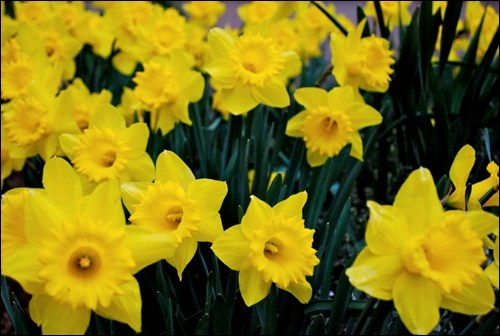While the date for Easter is variable from year to year [depends on the timing of the first full moon after the vernal equinox – this year, Easter Sunday falls on April 5], we can be sure that spring weather is not far behind. The other certainty is that stores will soon be selling plants to help celebrate the season. It’s no coincidence that most traditional Easter plants naturally flower in early spring but in more temperate climes. Two common but very different bulbs are referred to in Europe or North America as the Easter lily: one is a lily, the other a daffodil.
A white lily is the most common plant gracing Churches and homes during Easter. In Christian tradition and art, it symbolizes purity, virtue, innocence, hope and life. Emerging from a seemingly lifeless bulb, the lily has also been used to represent the resurrection of Christ. Legend tells us that drops of perspiration shed by Christ while in the Garden of Gethsemane were miraculously transformed into white lilies.
The Madonna lily (Lilium candidum), with its pure white blooms on sturdy stems, was adopted by 12th century Christians to represent the Virgin Mary. But because it does not flower in time for Easter under natural conditions, the earlier flowering Bermuda lily (Lilium longiflorum) has been used since the 1880s to mark the holiday. Greenhouse growers have learned how to “trick” or “force” Easter lilies into bloom at precisely the right time each year by controlling temperature and day length.
When choosing an Easter lily, look for plants with blooms in various stages of development, from buds to slightly open flowers. Leaves should be dark glossy green, dense and down to the soil. To extend its blooming period, place it in a cool location, away from drafts and out of direct sun. Water only when the soil begins to feel dry. Removing the pollen bearing anthers does two things: it extends the life of the bloom, and prevents the sticky yellow pollen from coming into contact with fabric (e.g. your best shirt or blouse). Remove any pollen from clothing with sticky tape rather than trying to wipe it off.
In Norway and other European countries, the traditional Easter plant is the Påskelilje, literally meaning “Easter lily. “The Påskelilje is what we know as the daffodil (Narcissus spp.). In fact, early common names for daffodil included Easter lily and Lent lily. The daffodil symbolizes rebirth, hence its association with the celebration of the resurrection of Christ.
It might be surprising to learn that North America’s second largest daffodil grower is in Canada. Longview Farms, formerly Vantreight Farms, on Vancouver Island has an annual production of nearly 20 million flowers, shipped throughout the world. They’re in full harvest mode right now, desperately looking for pickers. There’s a good possibility that daffodils you purchase this spring came from this farm.
Daffodils are available in bundles and should be bought with most of the buds closed. Stems should be rcut with a sharp knife and placed in water immediately upon arriving home. For maximum vase life, keep them in a cool location out of bright light. Re-cut the stems and replace the water every two or three days. If you have a mixed arrangement of daffodils and other cut flowers, you’ll need to keep the daffodils in a separate vase for a couple of hours after cutting. Otherwise, the slimy alkaloid sap that bleeds off the cut ends will shorten the vase life of the other flowers.
This column is provided courtesy of the Saskatchewan Perennial Society (www.saskperennial.ca; [email protected]). Check out our Bulletin Board or Calendar for upcoming garden information sessions and other horticulture events: Gardenscape, March 27 – 29 at the Saskatoon Exhibition Grounds.




